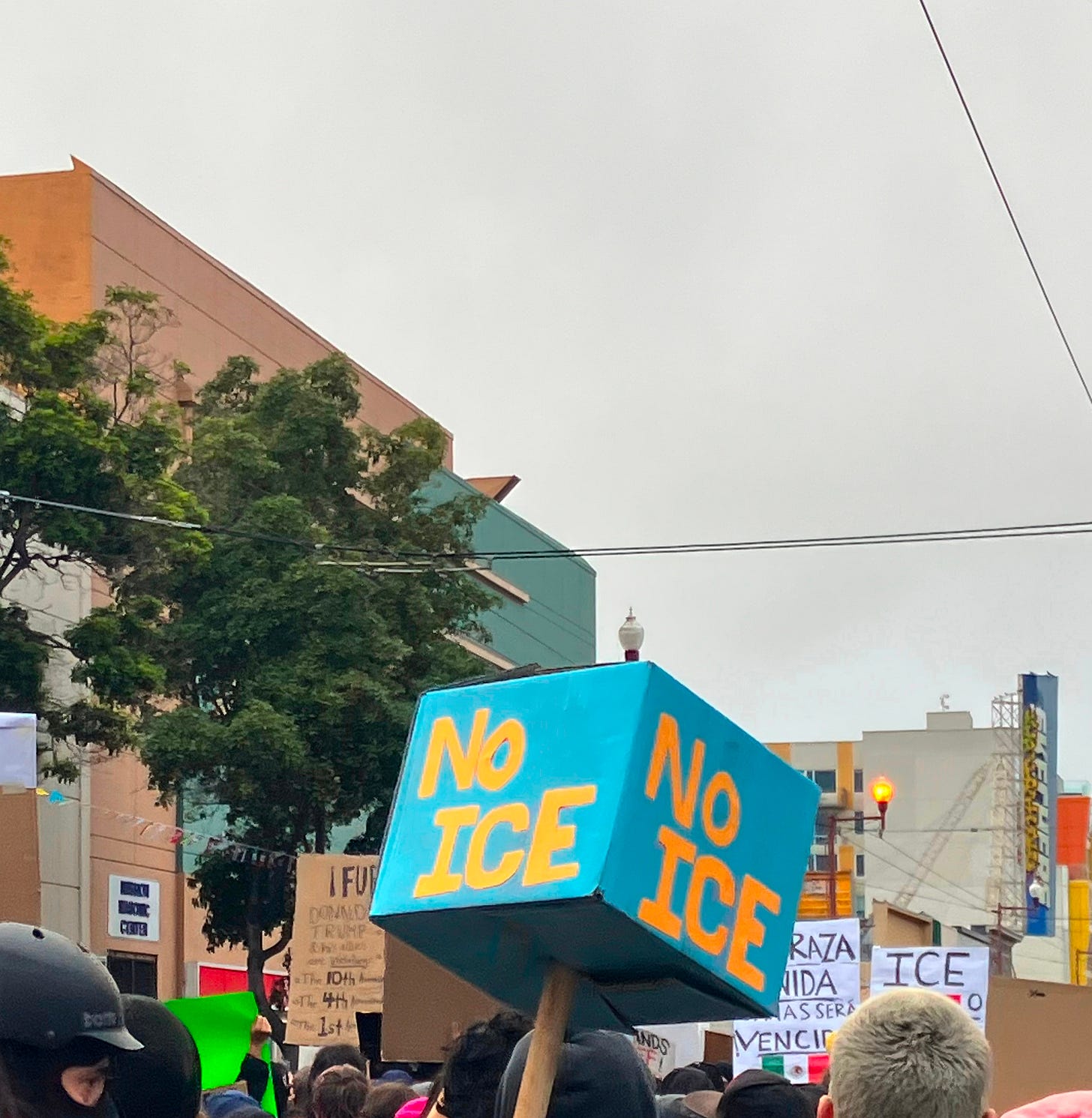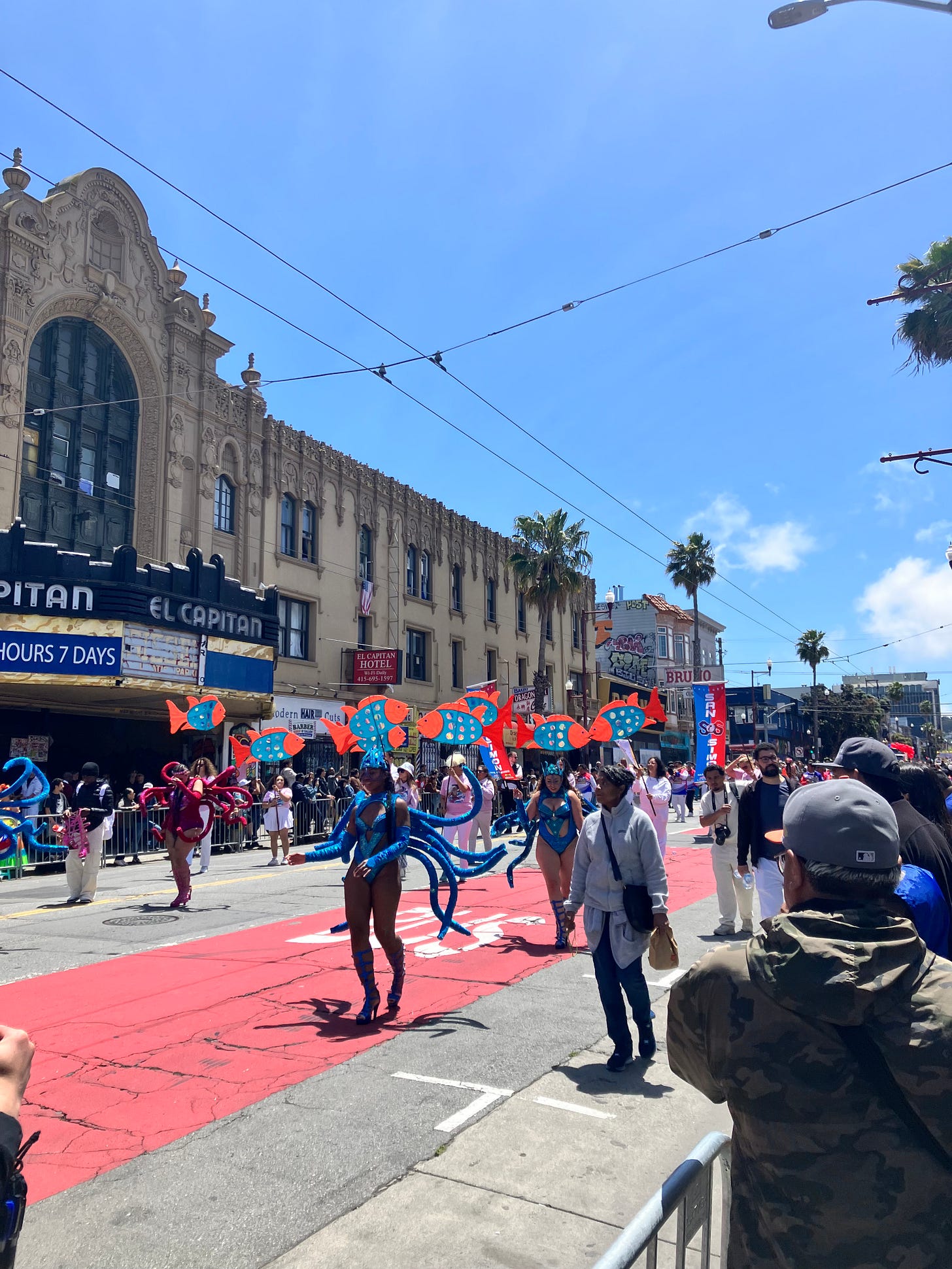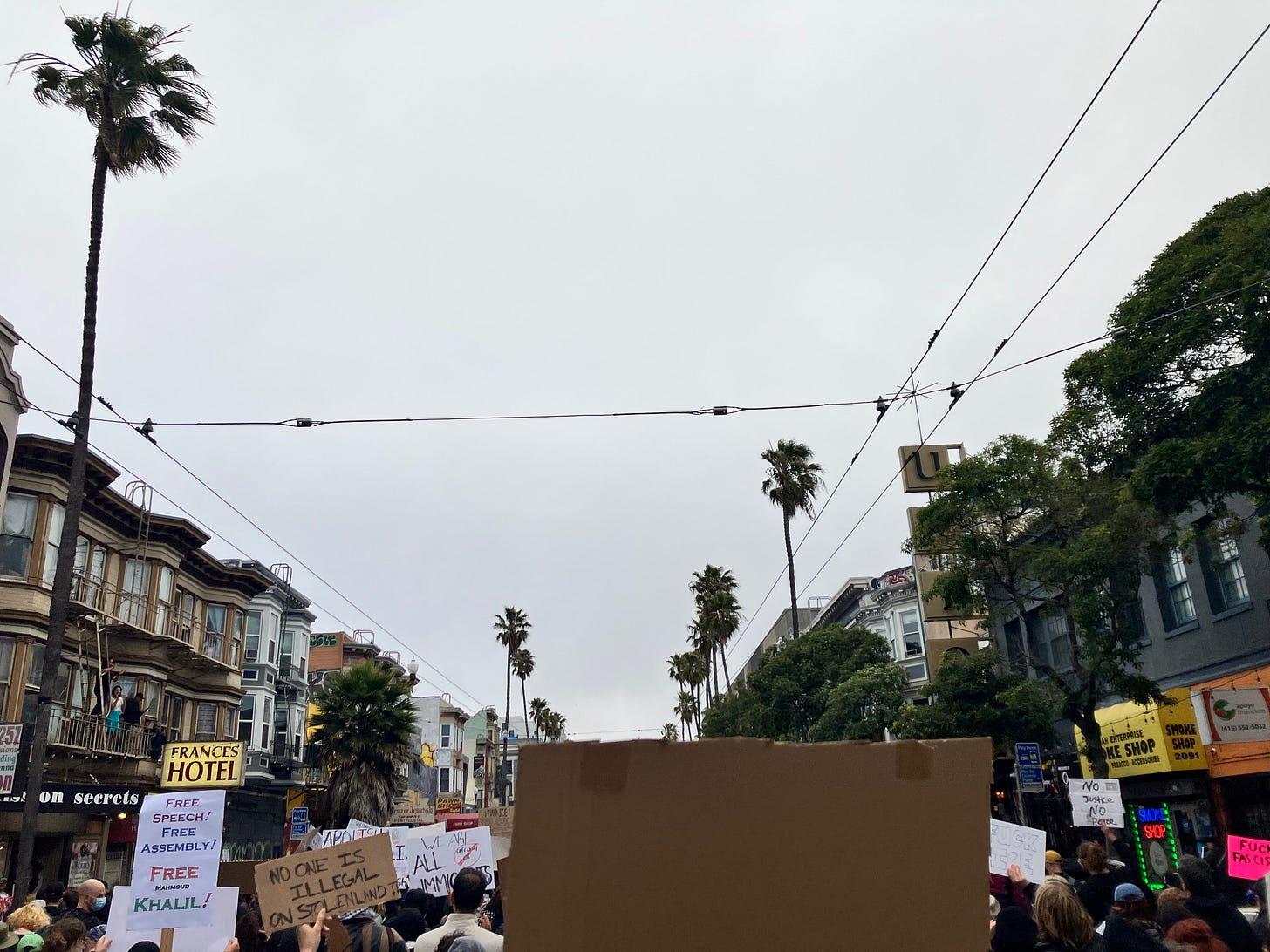On Monday, I went on a walk in the Mission neighborhood of San Francisco with thousands of people. Andy and I took the bus down Van Ness, getting off to walk down 24th Street. A cafe we walked past had pitchers of water on the sidewalk that said “we take care of each other. No ICE” (there was, of course, no ice in the water pitchers).
As we neared 24th and Mission Street, the scent of burning sage became stronger. The intersection was flooded with hundreds of people, turning onto Mission to start marching. We joined the tide.
For those not from around here, the Mission neighborhood is the historic center of Latino/Chicano culture in San Francisco and Mission Street runs a slightly askew North/South through it. Just a few weeks ago, I’d been watching a very different walk down Mission — the Carnaval Parade with its floats and colorful matching outfits and huge groups of people dancing in unison. This time, Mission was much more subdued. Gone was the sun and the heat. Instead, there was a chill in the air, and the palm trees looked odd and sad against the grey sky.
I noticed new things walking straight down the middle of Mission Street — a street whose sidewalks I’ve walked probably hundreds of times. A new perspective on the House of Jeans, and the portrait studio with the giant glamor shot on the marquee, and the Lucky Pork Market (whose pigs weren’t particularly lucky, as Andy pointed out), and the pay day loan places, and the occasional fancy bar, and the marijuana dispensaries, and the weird off-brand discount stores, and the dive bars, and the taquerias, and the empty lots filled with plants, and the SROs.
As we marched further down Mission, more people came out to watch. I spent a few blocks just looking up, watching people watch us from their homes — places they’ve somehow managed to hold onto despite the relentless gentrification of the neighborhood. The crowd cheered at a little boy who was waving excitedly at us from the balcony of his building. A barber took the big flag that advertised his shop and was waving it around, seemingly in support, wanting to get in on the activity. A family clung to a fire escape, waving a Mexican flag. People leaned out of windows and joined in on the chants. The march, which had seemed so subdued and serious, started to get a little more lively thanks to the people above.
We turned onto 16th and then back onto Valencia, a street that couldn’t be more different from Mission. While Mission Street mostly still caters to working class folks, Valencia is where the rich hipsters hang out. It’s where you can buy an $8 muffin or a fancy kitchen knife. This may be a bit of an over-generalization, but the vibes shift between the two streets is very real. The people eating outside at the nice restaurants were largely uninterested in the crowd of people marching past them.
Soon, we passed the Mission Police Station, which was fenced off and surrounded by 50 or so cops in riot gear, with beanbag snipers on the roof. It was overkill, since the only thing the crowd did was yell at them, but if there’s one thing SFPD knows how to do, it’s waste resources. (The latest scandal involves officers calling in sick and then working private security, a practice that has blown through SFPD’s overtime budget. Instead of cracking down on a practice that would literally get you fired in any other job, the Mayor is asking for even more money for the police during this budget cycle).
The grey skies began to turn darker, so we decided to peel off from the march and head back home. Later, I learned more than 5,000 people were there.
This is a type of walk that I haven’t written about much in this newsletter (with the exception of the Mass Trespass ) and it may seem strange to write about a protest as a walk. But walking is, of course, foundational to so many fights for justice — from the Salt March to picket lines. Beyond all of the tactical and strategic reasons for these walks, I think there’s something in walking itself that brings people together. There is an energy in masses of people moving with each other, connecting the forward movement of feet to the forward movement of a cause. There’s a camaraderie that is formed, especially on days-long marches or picket lines. There is something about walking that opens people up to each other, gets them talking in ways they wouldn’t if they were standing still and looking directly at each other.
And being together, moving together, gives us all courage. I learned one of my favorite examples of this phenomenon when visiting Leipzig, Germany. During the lead up to the fall of East Germany, activists would gather every week for “Prayers for Peace” at Nikolai Church and go on a little march. At the start, there were more informants than genuine activists, so the marches looked larger than they would’ve been otherwise, which gave people courage to come out the next week, which necessitated more informants. Eventually (too late) the Stasi realized that by sending so many informants, they were accidentally encouraging broader participation from society. People didn’t know half the marchers were Stasi — they saw growing numbers of people in the streets and that made them feel brave enough to join the next week, until, eventually, an additional 100,000 protesters joined each week in marches around the country, a stunning surge that led months later to the collapse of East Germany and eventually the USSR.
Walking together doesn’t solve everything, but it does start some things, and, as Californians and especially Angelenos have shown this week, walking is one way for us to protect each other, to show our care for our neighbors, to demonstrate that we aren’t scared of pathetic, vile, wannabe fascists. See you in the streets.








I’ll be joining you by walking in the “No Kings” demonstration in Harrisburg tomorrow. Time to stand up to this wannabe dictator.
Walk On!!!